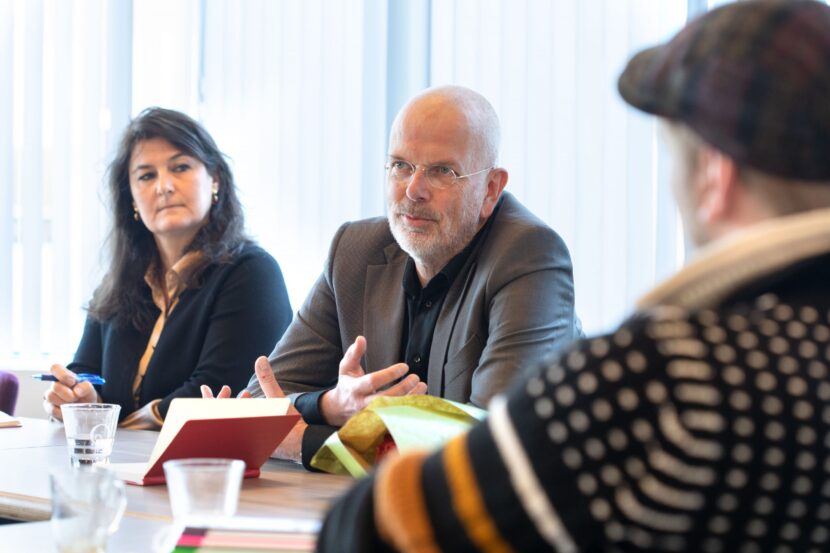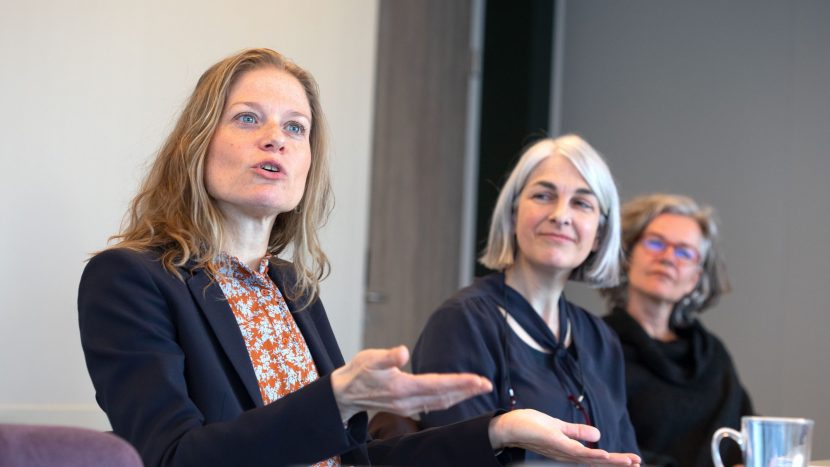Tuesday, March 8, the time had come. In the context of International Women’s Day, the Diversity & Inclusion network met with students and employees to discuss gender balance in the workplace and in the classroom during a hybrid event.
Jan Bogerd, president of the Executive Board, addressed the attendees from his role as father of daughters. Given the current situation in Ukraine and Russia, he referred to the tradition of Women’s Day in these countries where women receive flowers in appreciation and solidarity.
 Diversity Officer, Elena Valbusa (links) en Voorzitter van het College van Bestuur, Jan Bogerd (rechts)
Diversity Officer, Elena Valbusa (links) en Voorzitter van het College van Bestuur, Jan Bogerd (rechts)
How did it all start?
But how did it all start? And why is this holiday celebrated all over the world? Jan Bogerd listed some facts during the introduction of the event: “On March 8, 1908, about 15,000 women from the textile industry in New York went on strike against the poor working conditions. The strike became known as “Bread and Roses” due to the poetically worded demand.
The movement continued to Europe where women started fighting for their electoral and labor rights. In 1910, during the International Women’s Conference in Copenhagen, the proposal was made to declare March 8 as International Women’s Day. This was first celebrated in the Netherlands in 1912. International Women’s Day was not recognized by the United Nations until 1978. Despite its long history, March 8 continues to be a symbol of the militancy and solidarity of women around the world. To this day there is violence, oppression, poor employment and trafficking in women, all at the expense of women everywhere, of course.”
What about the Hogeschool Utrecht?
Jan Bogerd went on to say that no less than 63% of the employees of Hogeschool Utrecht identify as female. He then called for attention to, among other things, equal pay and equal opportunities for existing positions. “The role of HU as an educational institution is a pedagogical task towards society. As a result, the university of applied sciences is responsible for helping students regardless of their gender. The university of applied sciences should take the lead by setting an example to the business community about what it should be like when it comes to gender balance”.
 Keynotespreekster Rosie Zheng (links)
Keynotespreekster Rosie Zheng (links)
Ambiguous Compliments
The keynote speaker of the day was Rosie Zheng, winner of the 2021 ECHO STEM Award for science and technology. After high school she started her study career with the Bachelor of Psychology. Rosie actually had a preference for artificial intelligence, but the social profile in high school made it difficult to get in. In the end she followed her heart and switched to Bachelor Artificial Intelligence.
Rosie indicated that she found it remarkable that people’s reaction to her study changed. While the reactions to her bachelor’s degree in psychology were neutral, she received ambiguous compliments about her choice for artificial intelligence. Things like “how clever that you can study this” didn’t feel like a compliment to her because it would indirectly imply that a woman would not be capable of doing such a study in the first place. She therefore wondered whether her male student colleagues also received such compliments for their choice of study. With her psychology background, the question started to grow as to where the gender bias came from.
Gender bias
Gender bias is about specific competences that are only assigned to a person on the basis of his or her gender. This creates problems for the person concerned if he deviates from the set standards. As an experience expert, Rosie introduced a number of factors that influence this. It all starts, says Rosie, from childhood where certain toys, colors and clothes are offered to children based on their physical gender. Parents and a lack of role models play a crucial role in this.
The video below demonstrates the formation of gender bias in childhood.
Figures and causes
Childhood forms the frame of reference in which the individual makes choices that ultimately also influence the previous education. Rosie, for example, discussed a number of telling figures about the distribution of science, technology and IT. While the gender distribution is 50% in primary education, this increases to 37% in the exact profiles in secondary education. This thins out in technical studies to only 25% women with ultimately only 14% women in the labor market in these sectors. According to Rosie, there are mainly three reasons for this, namely; environment, professional image and self image. Influences from family, friends and education demotivate young women to choose a technical sector. In addition, the stereotyped occupational image that the tech sector brings along discourages many women because they cannot identify themselves with those stereotypes. Finally, the self-image, fueled by the gender bias in childhood, causes women to underestimate themselves.
What you can do
Despite the above, Rosie is optimistic about the future and she gave three tips:
- Encourage girls and women in tech
- Immerse yourself in biases and see if you can correct others and yourself in this
- Say what you say to a girl to a boy and vice versa
 Paneldiscussie
Paneldiscussie
Discussion
Lecturer in Technical Informatics at the HU, Gera Pronk, explained her position as a woman in a technical world. She was often asked to join so-called “women’s clubs” because as a woman she practiced something “masculine”. She found this difficult because as a woman she did not want to stand out and wanted to belong to the men. According to Gera Pronk, diversity and inclusion encompasses so much more than just gender.
In her role as mother of a girl and boy, Bregje Pieters of the Technical Education thought it was important to be aware of the differences between gender by recognizing and acknowledging them. This allows for a better response to the needs of the child. She too has seen from personal experience how the primary education falls short in providing necessary materials. For example, Bregje sees that there is always enough craft material on offer and that there is much less on offer in technology.
“We don’t want fewer men, we want a lot more women.” – according to Regine Kruijsdijk of the ICT Institute of the HU. She grew up in a woman’s family and her father encouraged her and she got tech Lego on her birthday. Despite the discouragement of her high school teacher, Regine went on to follow her passion. She emphasized the importance of the bond between women in a man’s world because it offers support. To this end, there is a network for women at the ICT Institute and courses are offered for girls to promote programming skills.

The same dilemma is of course also experienced the other way around. Social Work students, Idris in ‘t Hof and Joram van Velzen, are two of the few men in the programme. As a graduation assignment, they investigate gender roles in care services. According to them, there are no discussions about the gender balance in their education. Some men find it uncomfortable to express an opinion on women’s issues. For both men there is a big question, namely; how can you properly relate to a healthy masculinity and still engage in the conversation? They believe that there should also be a focus on new healthy male role models. The book by Martine Delfos, The beauty of difference, therefore emphasizes that it is not bad to differ as long as quality is recognized and used.
Ultimately, the panel agreed that the focus should be on lowering barriers and ensuring accessibility so that entry is easy regardless of gender identity. Elena Valbusa concluded with a summary and the conclusion that there is still a lot of work to be done. Hence the importance of maintaining a dialogue with each other.
Interesting?
If you also want to participate in such conversations, keep an eye on the network’s website. Do you have relevant literature, research or tips related to this topic? Then share that with us via info.di@hu.nl
Did you find this interesting? Check out what else the Network D&I has to offer via current.
Do you have any comments, do you want to share your story or would you like to meet? Please contact us via the contact form. We like to keep in touch.
